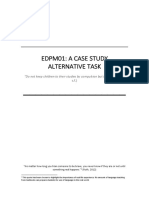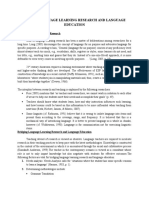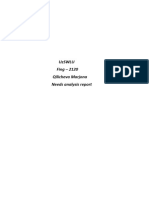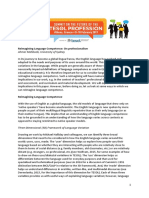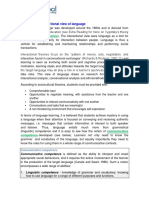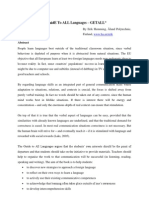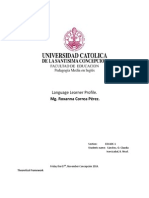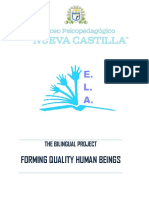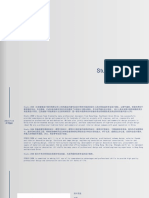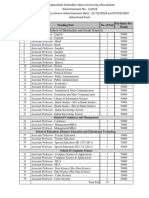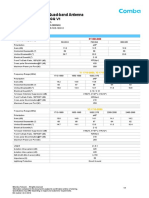Action Research as a Method for Implementing a 2-phase English
Development Project in the Publications Office in the EU
1. Introduction
Being one of the founding principles of the European Union (EU), multilingualism is an
important policy of the EU. Yet, while there are numerous educational programs supporting
the language training and learning of every EU citizen, there are few initiatives which aim to
improve the language capabilities of its staff. Thus, an innovative language development
project ought to be implemented in a unit in the EU as a pilot scheme. It should then be
expanded to other groups after a thorough research and modification so that the language
proficiency of staff in the EU can be improved in the long term. This essay aims to discuss
Action Research (AR) as an appropriate research methodology to the research of the
effectiveness of such an innovative language development project. The research topic will first
be clarified. Next, the choice of action research will be justified, followed by the elaboration
of the research design, data collection and analysis. Possible pitfalls and solutions of the
research will then be discussed.
2. Research Topic
As the given research topic is too vague, there is a need to redefine the key terms and specify
the research plan in order to make the study researchable and unambiguous.
2.1 Target group of research
First, the target group of research is some staff whose first language is not English at
the Publications Office in the EU. English is chosen because it is one of the three
procedural languages in the EU, which means that it plays a vital role in the operation
of the projects. Therefore, it is ideal that the staff has a good command of English.
Moreover, the geographical location of the Publications Office explains the choice of
English in this research. It is located in Luxemburg where French and German are
official languages. It is believed that the staff generally may have little exposure to or
competence of English. The researcher(s) may choose participants whose English are
at beginners, intermediate and advanced levels so as to evaluate the impacts of each
group. 15-20 participants of each level should be selected from various sub-
organizations of the Publications Office using the Purposive Sampling, making a total
1
�of 45-60 candidates for the research. Purposive Sampling means that the researcher(s)
will select the participants purposively based on their typicality which includes age,
gender, nationality, position at the EU and experience in the EU from different sub-
units of the Publications Office. Meanwhile, one criterion should be executed strictly:
the mother tongue of the participants must not be English because the research focuses
on developing their English proficiency.
Their pre-English level can be tested by a formative assessment which includes reading,
writing, listening and speaking competencies. Then, participants will be streamed into
three groups which are beginners, intermediate and advanced according to their scores.
Also, the Publications Office is chosen because it is responsible for publishing
publications such as general documents, legal documents, official information on
websites on behalf of the EU. Hence, having a good command of English does not only
help them prepare the publications, but also to have a better communication with
different departments within the EU. After the research, the project may be modified
and extended to other units of the EU focusing on other languages.
2.2 Innovative language development project
By definition, a “project” sustains for a period of time rather than being a once-off event.
Also, it takes time to develop certain language abilities. So the project will last for a
long period of time and usually for years. This research project can then be divided into
two phases. The first phase aims to improve the listening and speaking abilities of the
participants while the second phase focuses on the reading and writing skills of them.
A designated English native speaker who is also a staff from the EU, who is called the
mentor in this project, will be assigned to each participant. The mentor will not
necessarily be from the Publications Office. He/she can come from other units of the
EU. This mentor-mentee relationship will last until the project ends.
In the first phase, the participants will conduct a 30-minute Skype call with the mentor
on every working day in 2 years. During the Skype call, they can discuss work-related
or non-work-related issues. Through having video calls, it is believed the listening and
speaking skills of the participants will be improved because they have to express their
own thoughts and comprehend the mentor’s ideas.
In the second phase, the participants will send messages via social networking
platforms such as Facebook, Instagram or WhatsApp with the mentor on every working
day in 2 years. It is hoped that they can have at least 10 utterances as conversations to
2
� each other on every working day. Likewise, they can write on various topics. The
second phase is regarded as an extension of the first phase. It aims to improve writing
and reading skills of the participants as they have to write and read in English.
This project is innovative because using technological advances such as Skype and
social networking platforms to learn a language is a relatively new idea in the 21st
century. Also, the two phases for the project strive to improve the English competency
of participants in an all-rounded dimension.
So, under the framework of AR, the AR question is “Implementing a 4-year 2-phase
comprehensive English improvement project for the non-native English speakers in the
Publications Office of the EU”.
3. Reasons for choosing Action Research (AR)
This section justifies the rationale of choosing AR in this language research of the EU.
3.1 Change provoking
Burns (2009, p.2) pinpointed that the basic of AR is to execute interventions that
provoke “changes, and even better improvements in practice”. Indeed, there are many
other scholars (Wallace, 2000; Gibson, 2004; McNiff, 2013) who characterize AR as
an agent of provoking positive changes and therefore, improving the current situations.
As this research concerns the development of language abilities of the participants, it
requires a long period of time for the improvement to occur. As abovementioned, 4
years is needed for such a positive change in language proficiency. Hence, AR is
suitable for this research.
3.2 Systematic
Stringer (2014) defined AR as “a systematic approach to investigation that enables
people to find effective solutions to problems”. Thus, being systematic is another
characteristics of AR. In this research, there will be multiple rounds of planning, action
and reflection in each phase by the participants. The data collection process is
systematic as well. Also, as the research cycle is spiral instead of cyclical, which means
the research if more focused and sophisticated as it progresses, the research is
systematic and organized.
3
�3.3 Practitioner and participant-oriented
Herr & Anderson (2005) defined AR as an “inquiry […] done by or with insiders”.
Nasrollahi, Krish, & Noor (2012) indicated that AR, as a qualitative research approach,
aims to seek greater understanding of the research question by focusing on a small
group of people. Unlike classroom research, there is no teacher in this scenario. Hence,
it is suggested that mentor(s) should be invited as the co-researcher(s) of this project so
that the validity of this AR will increase. Such a measure will be further discussed in
section 5.1.
3.4 Advantages of AR
Kuang & David (2017) quoted Hogarth (2005) that there are some advantages of using
AR. In this project, AR promotes a sense of ownership for the participants as it involves
their participation and reflection. Their motivation, understanding of the topic and
critical reflection will be escalated because of the strong sense of ownership, enlarging
the effectiveness of this project.
3.5 Reasons for not choosing ethnography
It may be argued that ethnography as another common qualitative approach may also
be selected for this research. However, it is not as appropriate as AR.
Firstly, ethnography only provides a descriptive account on the observation. Watson-
Gegeo & Ann (1988) suggests that the goal of ethnography is to explain interpretively
how people naturally perform under a particular context. However, this research
signifies a start of the project and it is not what people naturally do. It should not be
plainly observed and described only. Interventions have to be made during the research.
Therefore, ethnography fails to evaluate the effectiveness of the interventions. If the
research topic is to observe and describe the patterns of staff in Publications Office in
using English, ethnography may be a sound choice.
Secondly, ethnography “views people’s behaviors in cultural terms” (Nunan & Bailey,
2009). Ethnography focuses on identifying rules of communications and explain them
from a cultural perspective. However, cultural explanations of behaviours is not a
concern in this research. Thus, ethnography is not an appropriate research methodology
here.
4
� 3.6 Reasons for not choosing case study
Another frequently used naturalistic research methodology is case study. Yet, it is also
not appropriate for this research because of the scale of this research and its low
generalizability.
Firstly, there are 45-60 participants from the Publications Office in this research. Such
a large scale of participants does not fit case study as case study usually involves a
small number of individuals. Ideally, case study focuses on one individual only. If a
research involving people from the whole department, case study should not be selected.
Secondly, if the number of participants drops to one or two and case study is
implemented for this research, it is difficult to generalize the case to other departments
of the EU and bring a larger impact in the future. It is because there are countless
variables in a case study of individuals which may not be applicable to other staff.
Hence, if this research aims to act as a pilot scheme for the future development of the
EU, case study is not suitable as the research methodology.
4. Research design, data collection and analysis
4.1 Research design
Kemmis, MsTaggart & Program (1988) suggested there are 4 rudimentary elements of
AR: (1) developing, (2) implementing, (3) observing and recording, and (4) evaluating.
Nunan and Bailey (2009) later specified them into 6 stages, including (1) identifying,
(2) planning, (3) implementing, (4) observing, (5) reflecting, and (6) repeating. There
should be at least 2 cycles of planning, action and reflection in an AR. Table 1 illustrates
1 cycle of this research following the model by Nunan and Bailey (2009).
Table 1 A suggested cycle of the research
Actions or examples in Actions or examples in Phase
Phase 1 2
Step 1 Form English of participants will English of participants will be
hypothesis be improved by having improved by having
Skype video calls with the conversation on Facebook
mentor. Messenger with the mentor.
5
� Step 2 Plan Participants have a pre-test Not applicable
intervention for the potential
participants.
Step 3 Take action The project starts/continues and researcher(s) record the data.
and observe
outcomes
Step 4 Reflect on Participants self-reflect an Participants self-reflect an
outcomes improvement in listening improvement in reading only.
only.
Step 5 Identify Researcher(s) suggest Researcher(s) suggest writing
follow-up talking about daily lives longer pieces of utterances
puzzle may be more effective. may be more effective.
The cycle should be run on a monthly basis and repeat until the project ends so as to
achieve a higher level of effectiveness by ameliorating the actions.
A formative assessment of similar level of difficulty as the pre-test will be done at the
end of the project to evaluate the effectiveness of the project.
4.2 Data collection and analysis
Method triangulation is used to collect data in this AR in order to have a more
comprehensive analysis of the project. Also, both participants and mentors should be
well-informed of the process of data collection and analysis. Their approvals have to
be sought before the project starts.
4.2.1 Videotaping conversations and recording emails
The video calls on Skype and conversations on social media platforms will be
recorded. Researcher(s) will evaluate variables such as content, length,
formality, diction and sentence patterns in the spoken and written dialogues and
correlate the variables with the improvements of the participants. The
researcher(s) should also attend some video call sessions and chatting occasions.
6
� 4.2.2 Keeping a journal
Both participants and mentors are obliged to keep a journal in which they should
record the contents and feelings of the interventions qualitatively. So that they
can both reflect as reflection-in-action, which means recalling what happened
and reflecting on it, brings improvement to the participants as Schön (1983)
mentioned that no improvement can be made without reflection.
4.2.3 Completing a monthly questionnaire
At the end of each month, both participants and mentors are required to
complete a questionnaire which follows the format of Thorpe (2004, p.39) from
Nunan & Bailey (2009, p.238) to evaluate their development. The researcher(s)
will then gather and analyze the responses on the questionnaires in which
students draw a single, straight line ( | ) on the horizontal continuum ( __ ) to
show their opinions.
4.2.4 Interviewing focus group monthly
Besides, the researcher(s) will conduct a monthly focus group interview with a
randomly selected pair of participant and mentor to collect and analyze their
opinions on the learning process and the effectiveness of the project.
5. Pitfalls
There are some noticeable pitfalls for this research project. In this section, potential pitfalls and
solutions will be discussed.
5.1 Unclear role of researcher(s)
The researcher(s) of AR is best to be a teacher researcher. Burns (2009, p.2) explains
the essence of having the teacher as the researcher in an AR. However, this research
project in the EU is unlike any classroom research and the staff in the organization will
not be the primary researcher, who is neither the participant nor the mentor.
One possible solution is that one or more researchers is to be assigned for this research
and he/she has to be a mentor of the project. It means that he/she is a staff at the EU
and his/her role is similar to that as a teacher’s in a classroom research.
7
� 5.2 Influence of the first language as a confounding variable
One of the prominent confounding variables which may obscure the results is the
mother tongue of the participants. Their first language may affect their learning
outcomes in the project depending on the resemblance of first language and English.
For instance, French participants may have a greater learning efficiency than German
ones as French resembles lexically and phonologically to English more than German.
The researcher(s) has to take it into consideration when selecting participants before
the project starts and analyzing the data in order to minimize the effect.
5.3 Lack of motivation
The participants and mentors may have little motivation to have dialogues at first. So,
it is expected that they build a good relationship with each other at the beginning of
Phase 1 because it is spoken and the time is more limited. Eventually, they can turn to
written dialogues which the time is not limited.
Inviting mentor(s) to be researcher(s) will uplift their motivation in the project as well.
5.4 Participants may quit the job or the project
Participants may leave the EU at any moment of the project as they are only employees
of the organization. Indeed, the number of 45-60 participants are recruited in total has
taken into consideration that there may be participants who quit the job or the project.
6. Conclusion
This essay depicts AR, together with method triangulation in data analysis, as an appropriate
research methodology when investigating the effectiveness of a 2-phase English development
project in the Publications Office in the EU. AR is chosen mainly because this project aims to
ignite a positive change in the English ability of the participants. By executing method
triangulation, it is hoped that the results can be comprehensively substantiated and given the
considerable level of external validity, the results are useful for other similar projects in the EU
in the future which can improve the language abilities of its staff.
(2,643 words)
8
�References
Burns, A. (2009). Doing action research in English language teaching: A guide for
practitioners. New York: Routledge.
Gegeo, W., & Ann, K. (1988). Ethnography in ESL: Defining the essentials. TESOL Quarterly,
22(4), 575-592.
Gibson, N. (2004). Action research. In M. Lewis-Beck, A. Byman, & T. F. Liao (Eds.), The
SAGE encyclopedia of social science research methods. Thousand Oaks, California: SAGE.
Herr, K., & Anderson, G. L. (2005). The action research dissertation: A gudie for students and
faculty. Thousand Oaks, California: SAGE.
Hogarth, S. (2005) The inter-relationship between teaching and research at the University of
York 2004. Survey for the forum for the enhancement of learning and teaching. Retrieved from
http://www.york.ac.uk/felt/gpresource/research&teaching.html
Kemmis, S., McTaggart, R., & Program, D. U. S. o. E. O. C. (1988). The action research
planner. Deakin, India: Deakin University Press.
Kuang, C. H., & David, M. K. (2017). Empowering language teachers through action research:
Two case studies from Malaysia. English Review: Journal of English Education, 5(2), 163-174.
McNiff, J. (2013). Action research: Principles and practice (3rd ed.). Abingdon: Routledge.
Nasrollahi, M. A., Krish, P., & Noor, N. M. (2012). Action research in language learning.
Procedia - Social and Behavioral Sciences, 47, 1874-1879.
Nunan, D., & Bailey, K. M. (2009). Exploring second language classroom research: A
comprehensive guide. Boston: Heinle.
Schön, D. A. (1983). The reflective practitioner: How professionals think in action. New York:
Basic books.
9
�Stringer, E. (2014). Action research (4th ed.). Thousand Oaks, California: SAGE.
Thorpe (2004). Coal miners, dirty sponges, and the search for Santa: Exploring options in
teaching listening comprehension through TV news broadcasts, Unpublished manuscript,
Monterey Institute of International Studies, Monterey, California.
Wallace, M. J. (2000). Action research for language teachers. Cambridge, UK: Cambridge
University Press.
10




